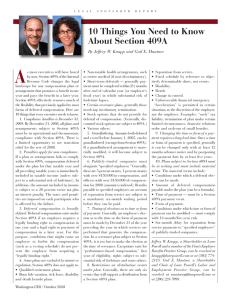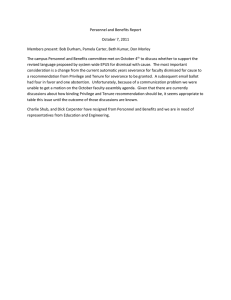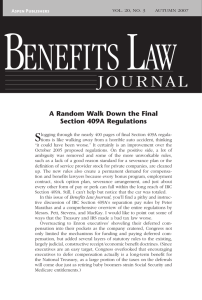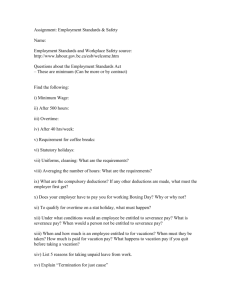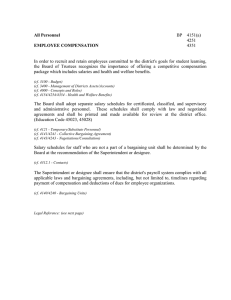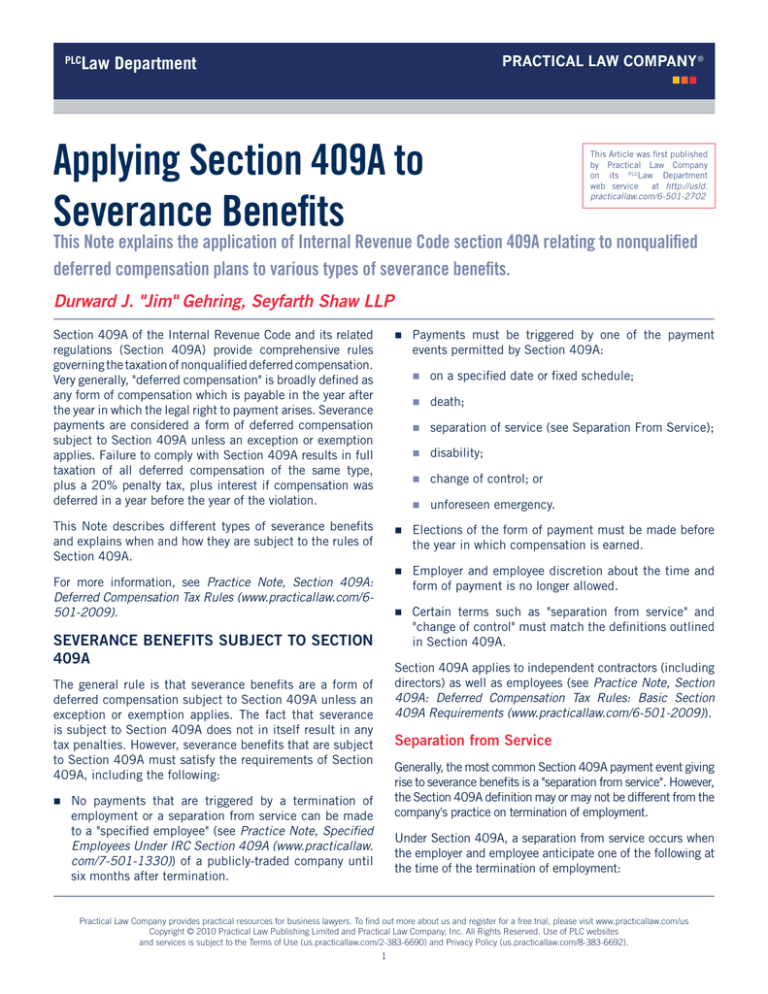
Law Department
PRACTICAL LAW COMPANY ®
PLC
Applying Section 409A to
Severance Benefits
This Article was first published
by Practical Law Company
on its PLCLaw Department
web service
at http://usld.
practicallaw.com/6-501-2702
This Note explains the application of Internal Revenue Code section 409A relating to nonqualified
deferred compensation plans to various types of severance benefits.
Durward J. "Jim" Gehring, Seyfarth Shaw LLP
Section 409A of the Internal Revenue Code and its related
regulations (Section 409A) provide comprehensive rules
governing the taxation of nonqualified deferred compensation.
Very generally, "deferred compensation" is broadly defined as
any form of compensation which is payable in the year after
the year in which the legal right to payment arises. Severance
payments are considered a form of deferred compensation
subject to Section 409A unless an exception or exemption
applies. Failure to comply with Section 409A results in full
taxation of all deferred compensation of the same type,
plus a 20% penalty tax, plus interest if compensation was
deferred in a year before the year of the violation.
This Note describes different types of severance benefits
and explains when and how they are subject to the rules of
Section 409A.
For more information, see Practice Note, Section 409A:
Deferred Compensation Tax Rules (www.practicallaw.com/6501-2009).
SEVERANCE BENEFITS SUBJECT TO SECTION
409A
on a specified date or fixed schedule;
death;
separation of service (see Separation From Service);
disability;
change of control; or
unforeseen emergency.
Elections of the form of payment must be made before
the year in which compensation is earned.
Employer and employee discretion about the time and
form of payment is no longer allowed.
Certain terms such as "separation from service" and
"change of control" must match the definitions outlined
in Section 409A.
Section 409A applies to independent contractors (including
directors) as well as employees (see Practice Note, Section
409A: Deferred Compensation Tax Rules: Basic Section
409A Requirements (www.practicallaw.com/6-501-2009)).
The general rule is that severance benefits are a form of
deferred compensation subject to Section 409A unless an
exception or exemption applies. The fact that severance
is subject to Section 409A does not in itself result in any
tax penalties. However, severance benefits that are subject
to Section 409A must satisfy the requirements of Section
409A, including the following:
Payments must be triggered by one of the payment
events permitted by Section 409A:
Separation from Service
Generally, the most common Section 409A payment event giving
rise to severance benefits is a "separation from service". However,
the Section 409A definition may or may not be different from the
company's practice on termination of employment.
No payments that are triggered by a termination of
employment or a separation from service can be made
to a "specified employee" (see Practice Note, Specified
Employees Under IRC Section 409A (www.practicallaw.
com/7-501-1330)) of a publicly-traded company until
six months after termination.
Under Section 409A, a separation from service occurs when
the employer and employee anticipate one of the following at
the time of the termination of employment:
Practical Law Company provides practical resources for business lawyers. To find out more about us and register for a free trial, please visit www.practicallaw.com/us
Copyright © 2010 Practical Law Publishing Limited and Practical Law Company, Inc. All Rights Reserved. Use of PLC websites
and services is subject to the Terms of Use (us.practicallaw.com/2-383-6690) and Privacy Policy (us.practicallaw.com/8-383-6692).
1
Law Department
PRACTICAL LAW COMPANY ®
PLC
The employee will not perform any further services after
a certain date.
The level of services that the employee will perform
after a certain date (whether as an employee or an
independent contractor) is no more than 20% of the
average level of services the employee performed in the
previous 36 months.
severance benefits that the company can eliminate at any
time before the termination. Most broad-based severance
plans are designed in this manner and are exempt from
Section 409A if the severance pay is paid in a lump
sum shortly after termination. If severance pay is paid in
installments that could be paid in years after the year of
termination, the severance pay may be subject to Section
409A unless it meets one of the other exceptions.
In general, a separation from service requires an 80%
reduction in the average level of services, but agreements
may provide a threshold of as low as 50%.
For the same reason, severance benefits that are negotiated
at the time of termination, to which the employee had no
previous legal right, are also not subject to Section 409A.
However, if the severance benefits are in lieu of other rights
that were subject to Section 409A, the severance benefits
are then subject to Section 409A as well (see Practice
Note, Section 409A: Deferred Compensation Tax Rules:
Substitution Constitutes a Deferral of Compensation (www.
practicallaw.com/6-501-2009)).
If an employee has been terminated but continues to perform
services as a consultant or in another capacity for the employer
or any affiliate, the employee may not have a separation from
service if the level of services is above the threshold level.
However, a change in status from director to employee or vice
versa can qualify as a separation from service.
Disputes About Entitlement
An employee who ceases to perform services but is kept on the
payroll for other purposes (for example, continuation of medical
coverage) has separated from service (see Practice Note,
Section 409A: Deferred Compensation Tax Rules: Separation
from Service (www.practicallaw.com/6-501-2009)).
If there is a bona fide dispute concerning the employee's
entitlement to a form of compensation that is otherwise
subject to Section 409A, a lump sum payment in settlement
of the dispute does not violate the rule against accelerating
payment of deferred compensation provided that the
amount paid does not exceed 75% of the employee's claim.
For example, assume an executive has an employment
agreement providing that he be paid two years of base salary
in installments if terminated without cause and that the total
amount of payments to which the executive is entitled is
$1 million. If the company and the executive have a bona
fide dispute about whether he was terminated for cause and
they agree to settle the dispute by a lump sum payment
of $500,000, the payment in a lump sum does not violate
Section 409A even though an accelerated payment of
deferred compensation is generally prohibited.
Tax Reporting of Severance Pay
Severance pay must generally be reported on Form W-2
(or Form 1099-MISC for an independent contractor) in the
year of termination rather than the year of payment if it is
subject to Section 409A. While this does not mean that it
is taxable in the year of termination, it must be reported.
However, the IRS has waived this reporting requirement
until it finalizes the regulations on reporting compensation
subject to Section 409A.
SEVERANCE BENEFITS
SECTION 409A
EXEMPT
FROM
Payments Satisfying the Short-term Deferral Rule
Certain types of severance benefits are exempt from Section
409A because they do not involve the deferral of compensation.
Other types of severance benefits may be exempt under
special rules. Severance benefits can be exempt from the
Section 409A rules under the following circumstances.
Payments made within a short time frame after the
close of a year are not deferred compensation. This is
called the short-term deferral rule. If the employer uses
a calendar year, compensation that is paid no later than
March 15 after the year in which the employee's right to
compensation is no longer subject to a substantial risk of
forfeiture is exempt under the short-term deferral rule (see
Practice Note, Section 409A: Deferred Compensation Tax
Rules: Substantial Risk of Forfeiture (www.practicallaw.
com/6-501-2009)). If the employer uses a fiscal year, the
No Legally Binding Right to Compensation
If the employee has no legally binding right to receive
compensation in a future year, there is no deferred
compensation in the first place. This is the case with
Practical Law Company provides practical resources for business lawyers. To find out more about us and register for a free trial, please visit www.practicallaw.com/us
Copyright © 2010 Practical Law Publishing Limited and Practical Law Company, Inc. All Rights Reserved. Use of PLC websites
and services is subject to the Terms of Use (us.practicallaw.com/2-383-6690) and Privacy Policy (us.practicallaw.com/8-383-6692).
2
Law Department
PRACTICAL LAW COMPANY ®
PLC
compensation must be paid by the later of March 15 or 2½
months after the end of the employer's fiscal year. Applying
the short-term deferral rule to severance payments means
that severance must be paid no later than March 15 of the
year following the year in which the right to the severance
is no longer subject to a substantial risk of forfeiture (see
Substantial Risk of Forfeiture).
Substantial Risk of Forfeiture
Applying the short-term deferral rule depends in part on
whether the right to the severance benefits is subject to a
substantial risk of forfeiture before the date of termination.
As a general rule, if the severance benefits are payable
only on an involuntary termination, they are subject to a
substantial risk of forfeiture. However, if the severance
benefits are also payable on certain voluntary resignations,
such as good reason resignations, the benefits may not
be considered forfeitable. The good reason rules (see
Termination for Good Reason) are used as a guideline for
determining if the right to severance benefits is forfeitable.
If payment of the severance is conditioned on the
employees' execution of a release of claims, as is
commonly the case, this can cause the severance
payments to fail to qualify under the short-term deferral
rule even if the severance is actually paid by March 15
of the following year, unless the severance agreement
specifies a deadline by which the release must be
signed or the severance is forfeited. IRS Notice 20106 specifies the circumstances under which a release
provision does not cause a severance agreement to violate
Section 409A and permits severance agreements that
do not comply with the requirements to be amended by
December 31, 2010 (see Effect of a Release of Claims
or Noncompetition Provision).
Effect of a Release of Claims or Noncompetition
Provision
A waiver or release of claims or a restrictive covenant
in a severance agreement do not subject an employee's
separation pay to a substantial risk of forfeiture. Where the
employee has control over the performance of a condition
(such as whether to sign a noncompetition agreement or
to release claims), a substantial risk of forfeiture does not
exist. The separation pay is subject to Section 409A and
must meet the Section 409A payment timing requirements.
To solve this problem, the agreement should provide for
payments at a fixed time or on a fixed schedule, subject
to the employee signing and not rescinding a release of
claims or noncompetition agreement.
The short-term deferral rule applies to lump sum
severance pay that is paid not later than March 15
of the following year. If the severance pay is paid in
installments, the short-term deferral rule can apply to
the installments paid by March 15 if the agreement
provides that each installment is a separate payment for
Section 409A purposes.
Severance Pay Exception
The short-term deferral rule cannot be used for payments
that are a substitute for other types of deferred compensation
even if the payments are made by March 15.
Severance pay that is payable only on involuntary
termination (or voluntary termination under a window
program lasting not more than 12 months, (see Definition
of Window Program) is exempt from Section 409A if it
meets the following conditions:
Note that if a contract provides that the employee has
walkaway rights to resign without good reason and receive
severance benefits after a specified occurrence (usually a
change of control), the short-term deferral rule does not
apply after the vesting event occurs if the payment could
occur after March 15 of the following year.
For example, an executive's contract provides that he is
entitled to severance pay if he resigns within one year
following a change of control. Because his resignation may
occur after March 15 of the year following the change of
control, the short-term deferral rule no longer applies to his
severance pay once the change of control occurs and the
severance pay is subject to Section 409A even if payment
is actually made by March 15.
It is paid by the end of the second year following the
year of termination.
It does not exceed the lesser of two times the:
employee's base salary at the end of the year before
the year of termination; or
limit on compensation under a qualified retirement
plan (currently $245,000 in 2010).
To qualify for this exception, the severance pay must be
payable only on involuntary termination of employment (or
voluntarily under a window program). If the agreement permits
Practical Law Company provides practical resources for business lawyers. To find out more about us and register for a free trial, please visit www.practicallaw.com/us
Copyright © 2010 Practical Law Publishing Limited and Practical Law Company, Inc. All Rights Reserved. Use of PLC websites
and services is subject to the Terms of Use (us.practicallaw.com/2-383-6690) and Privacy Policy (us.practicallaw.com/8-383-6692).
3
Law Department
PRACTICAL LAW COMPANY ®
PLC
payment on voluntary termination of employment (other than
under a window program), it doesn't qualify for the exemption
even if the employee's actual termination is involuntary.
to whom the employee reports, including a
requirement that the employee report to a corporate
officer or employee instead of reporting directly to
the board of directors; or
Definition of Window Program
A window program is a program established by an employer
that is made available for a limited period of time (no
longer than 12 months) to employees who separate from
service during that period under specified circumstances.
A program is not considered a window program if the
employer establishes a pattern of repeatedly providing for
similar separation pay in similar situations for substantially
consecutive, limited periods of time. This determination is
based on certain facts and circumstances, including:
Whether the severance pay is on account of a specific
business event or condition.
The degree to which the separation pay relates to the
event or condition.
Whether the event or condition is temporary or discrete
or is a permanent aspect of the employer's business.
authority, duties or responsibilities of the supervisor
The amount, time and form of the payment for good reason
termination must be substantially identical to payment
made on an actual involuntary separation from service.
The employee must give notice of the existence of one
of the good reason conditions within 90 days of the
condition first occurring and the employer must have
30 days to cure the condition.
EMPLOYEE BENEFITS AND PERKS
In addition to cash severance payments, there are several
special rules that apply to different benefits and perks that
may be payable following termination.
Continued Medical
Reimbursements
Coverage
and
Medical
Continued medical coverage is not subject to Section 409A
if it is not taxable to the employee.
A material diminution in:
authority, duties or responsibilities;
Any other action or inaction by the employer
constituting a material breach of the employment
arrangement or agreement.
If set out in a collective bargaining agreement and applied
to employees covered under that agreement, severance pay
is not subject to Section 409A.
The good reason safe harbor requires that the separation
from service must occur during a predetermined limited
period of time of up to two years after one of the following
conditions arise (the good reason conditions must arise
without the consent of the employee):
Collectively Bargained Severance Arrangements
The general definition is a "material negative change" in the
employment relationship, and also takes into account factors
such as the notice the employee must give and whether the
severance is the same as for an involuntary termination.
base compensation;
A material change in the geographic location where the
employee must work.
The severance agreement should be drafted carefully. A
too liberal good reason clause is considered a voluntary
termination, even if the employee is terminated involuntarily
Many companies allow employees to resign if a good
reason event occurs but still receive severance benefits
as if the employees were terminated involuntarily. Under
Section 409A, a resignation for "good reason" qualifies as
involuntary termination only if the definition of good reason
specified in the agreement meets either the Section 409A
general definition or the safe harbor.
In addition, two conditions must be met for the good reason
safe harbor to be satisfied:
Termination for Good Reason
the budget over which the employee has authority.
Medical coverage that is taxable to the terminated employee,
for example, coverage that is provided by a self-insured
health plan that does not meet IRS non-discrimination
rules, is not subject to Section 409A during the COBRA
continuation health coverage period (for example, 18
Practical Law Company provides practical resources for business lawyers. To find out more about us and register for a free trial, please visit www.practicallaw.com/us
Copyright © 2010 Practical Law Publishing Limited and Practical Law Company, Inc. All Rights Reserved. Use of PLC websites
and services is subject to the Terms of Use (us.practicallaw.com/2-383-6690) and Privacy Policy (us.practicallaw.com/8-383-6692).
4
Law Department
PRACTICAL LAW COMPANY ®
PLC
months). However, if medical coverage lasts longer than
18 months, the coverage must comply with Section 409A
(see Reimbursements Subject to Section 409A).
Many employers take the position that continued
medical coverage is never taxable. However, when an
employer with a self-insured medical plan provides more
generous post-termination medical coverage for highly
compensated employees than it provides for the rank
and file employees, the coverage may be taxable. This is
an unsettled area and even if an employer believes that
its medical coverage is not taxable, it may wish to ensure
that it satisfies the Section 409A requirements to avoid
the potential for a penalty tax.
The reimbursement right cannot be liquidated or
substituted for other rights.
AND
EQUITY
The vesting or exercisability of options and stock
appreciation rights (SARs) may generally be either
accelerated or extended to not later than the original
expiration date or ten years from the grant date.
Extension or acceleration of an option or SAR that was
not originally subject to Section 409A does not make it
subject to Section 409A.
Continued life and disability coverage are exempt as welfare
benefits even if otherwise taxable.
Other Types of Equity Compensation
Miscellaneous Severance Amounts
Vesting of restricted stock may be accelerated without
subjecting the restricted stock to Section 409A.
A catch-all provision in Section 409A allows a limited amount
of otherwise taxable perks, such as continued car allowance
and club dues, to be exempt from Section 409A. The dollar
amount is tied to the 401(k) maximum contribution limit, which
is $16,500 (for 2010). Anything that exceeds this amount is
subject to Section 409A, unless it satisfies another exemption.
If other types of compensation, such as restricted stock
units, long-term incentive plans with a performance
period of more than a year and supplemental employee
retirement plans, are already subject to Section 409A,
vesting can be accelerated but changes in the time or
form of payment cannot be made.
REIMBURSEMENTS SUBJECT TO SECTION
409A
Incentive Compensation
To satisfy Section 409A payment timing rules,
reimbursements subject to Section 409A must comply
with the following requirements:
Reimbursement must be available for expenses incurred
during a defined time period such as five years. The
employee's lifetime is also a permitted time period.
Reimbursements must be paid by the end of the year
after the year in which the expense is incurred.
Stock Options and Stock Appreciation Rights
Continued Life and Disability Insurance Coverage
If the agreement also provides for an acceleration of the vesting
or payment of the employee's deferred or equity compensation,
the requirements of Section 409A must be followed.
Reimbursement for moving expenses, outplacement services
and any other expenses that the employee could deduct if
he paid for them himself are exempt from Section 409A if
the expenses are reasonable and are incurred by the end of
the second year after termination. Reimbursements must be
made no later than the end of the third year after termination.
Expenses eligible for reimbursement must be clearly
and objectively defined.
There must be a specified annual maximum amount of
payments with no carryover between years. However,
reimbursement of medical expenses can have a lifetime
rather than annual maximum.
PAYMENT OF DEFERRED
COMPENSATION
In-kind Benefits
If the employee has the right to receive incentive
compensation on termination regardless of whether
incentive targets are met, the employee may be required
to make any election to defer his incentive compensation
before the beginning of the performance period, rather
than six months before the end of the performance
period (see Practice Note, Section 409A: Deferred
Compensation Tax Rules: Timing of Deferral Elections
(www.practicallaw.com/6-501-2009)).
Practical Law Company provides practical resources for business lawyers. To find out more about us and register for a free trial, please visit www.practicallaw.com/us
Copyright © 2010 Practical Law Publishing Limited and Practical Law Company, Inc. All Rights Reserved. Use of PLC websites
and services is subject to the Terms of Use (us.practicallaw.com/2-383-6690) and Privacy Policy (us.practicallaw.com/8-383-6692).
5
Law Department
PRACTICAL LAW COMPANY ®
PLC
CHANGE OF CONTROL PROVISIONS
or 36 months severance payable in a lump sum on
termination of employment after a change of control. If
the change of control does not satisfy the Section 409A
definition, then half of the severance (representing the
first 18 months) must be paid in installments. However,
a portion of the first 18 months may be exempt from
Section 409A under either the short-term deferral
or severance plan exemptions (see Box, Example:
Interaction of Short-term Deferral Rule with Exception
for Involuntary Severance Pay).
The Section 409A regulations contain a definition of
change of control which in many cases is different from the
definition used in a company's other compensation plans.
A change of control definition that does not comply
with Section 409A can result in accelerated vesting
of deferred compensation, but it cannot result in
accelerated payment of amounts already subject to
Section 409A. Instead, payment on a change of control
or on termination following a change of control is
permitted only if the change of control qualifies under
Section 409A (see Definition of Change of Control).
Definition of Change of Control
The following constitute a change of control under Section
409A:
For example, an executive's agreement provides for
18 months severance payable in installments on
termination of employment before a change of control
Purchase of 50% of the company's stock measured by
value or voting power.
EXAMPLE: INTERACTION OF SHORT-TERM DEFERRAL RULE WITH EXCEPTION FOR
INVOLUNTARY SEVERANCE PAY
Assume an executive, who is a specified employee of a public company, has an employment agreement that provides
that if he is involuntarily terminated or resigns for "good reason" (defined in a manner that satisfies Section 409A), is
entitled to 1½ times his base salary plus target bonus, paid over 18 months. He is terminated on December 31, 2009,
when his base salary is $600,000 and his target bonus is 100%. He is entitled to $1.8 million in severance, payable
in eighteen monthly installments of $100,000 apiece. His base salary on December 31, 2008, was $550,000. The
company uses the calendar year for its fiscal year. The agreement requires the executive to sign a release to receive
the severance but it specifies the time by which the release must be signed in a manner that satisfies Section 409A.
If the agreement provides that each installment is treated as a separate payment for Section 409A purposes, then
the first three installments, payable on January 1, February 1, and March 1, 2010, totaling $300,000, are exempt
and can be paid even though six months have not passed since the termination.
For the remaining $1.5 million, the lesser of two times his base salary in the year before termination ($550,000)
or the compensation limit in 2009 ($245,000) is $490,000, so the first $490,000 is exempt as paid under a
severance plan. Therefore, the payments due on April 1, May 1, June 1 and July 1, and 90% of the August 1, 2010
payment, are also exempt from Section 409A. Although the remaining $1.01 million is subject to Section 409A,
by the time it becomes payable, the six months will have expired, so no further delay is required. However, it is still
subject to Section 409A and no change in the payment schedule can be made.
Now assume that the same executive's agreement provides that if his employment is terminated without cause or
for good reason following a change of control, he is entitled to three years base salary and bonus ($3.6 million),
payable in a lump sum on termination, and defines a change of control as sale of 25% of the company's stock. A
change of control occurs on December 1, 2009, and he is terminated on December 31, 2009, as described above.
Because the change of control did not satisfy the Section 409A definition, it cannot result in an acceleration of
payment. Accordingly, $1.01 million of his severance (the portion that would have been paid even if a change of
control had not occurred and was subject to Section 409A) must be paid in installments as described above and
the remaining $2.59 million can (and must) be paid in a lump sum.
Practical Law Company provides practical resources for business lawyers. To find out more about us and register for a free trial, please visit www.practicallaw.com/us
Copyright © 2010 Practical Law Publishing Limited and Practical Law Company, Inc. All Rights Reserved. Use of PLC websites
and services is subject to the Terms of Use (us.practicallaw.com/2-383-6690) and Privacy Policy (us.practicallaw.com/8-383-6692).
6
Law Department
PRACTICAL LAW COMPANY ®
PLC
Purchase within one year of stock having 30% of
the voting power. A higher percentage can be set but
the agreement cannot distinguish between different
blocks of stock.
Change in a majority of board membership over a oneyear period.
company that has guaranteed payment of the deferred
compensation for a valid non-tax reason (Practice Note,
Section 409A: Deferred Compensation Tax Rules:
Definition of Change in Control (www.practicallaw.
com/6-501-2009)).
STACKING OF EXEMPTIONS/EXCEPTIONS
Transfer of at least 40% of gross value of assets (a
higher percentage can be set in the agreement) to an
unrelated party. Approval of a merger or liquidation per
se is not qualified, but the asset transfer rule can pick
up most of these transactions.
The exemptions for various types of severance pay may
be applied in combination, or stacked. For example,
the severance pay exception can be used in conjunction
with the short-term deferral rule, as shown in the
example below.
The company that undergoes the change of control
must be the employee's employer, its parent or another
Practical Law Company provides practical resources for business lawyers. To find out more about us and register for a free trial, please visit www.practicallaw.com/us
Copyright © 2010 Practical Law Publishing Limited and Practical Law Company, Inc. All Rights Reserved. Use of PLC websites
and services is subject to the Terms of Use (us.practicallaw.com/2-383-6690) and Privacy Policy (us.practicallaw.com/8-383-6692).
7

